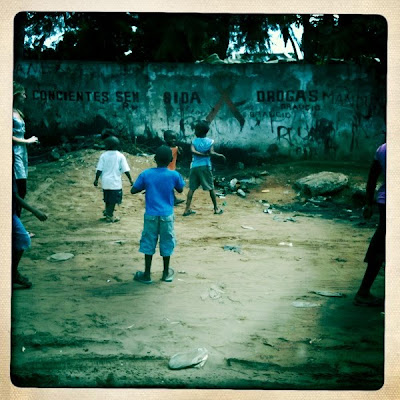 The writing on the wall.
The writing on the wall.During colonial times in the 40s and 50s, Mozambicans were not allowed to build brick houses unless they were integrated with the Portuguese culture. The result was a system similar to apartheid in which white, Portuguese and Mozambicans who were assimilated inhabited the heart of the city while the African population was referred to the outskirts where they built homes of corrugated iron. Mafalala is one of Maputo's oldest bairros, which is what they call the districts here, and was located right on the border between the white and the coloured area. For the people of Mafalala to be allowed to visit the "white" side it was required that they had a special ID card certifying that they had a job or a training course held in Lourenço Marques. However, it was also here that the resistance movement that would eventually get the Portuguese government on the case grew strong. Both the country's first president Samora Machel and his successor, Joaquim Chissano, has lived in Mafalala. But it is not only prominent freedom fighters that have their roots in the bairro. Among the cultural celebrities who come from Mafalala Noemi de Sousa is prominent. Her poems strongly contributed to the emergence of a black-consciousness movement in Mozambique. Simplified, one can say that Mafalala is to Mozambique what Soweto is to South Africa.
And how do we know all this? Well, yesterday we followed our Mozambican friend Ivan on a walking tour where he and two other guides during three hours talked about the cultural and political heritage of Mafalala. It wouldn’t be an understatement to say that we were swept away by the visit, as much because of the history as of today’s Mafalala kids. If our goal of the visit was to gain an historical insight of the Mozambican society so was the kids proceeds to hang with a bunch of mulungos. And how they interacted! Real attention seekers and completely charming little fellows. They danced, made somersaults and some of the kids had built up a small stage where they acted DJs, sang and danced. Kids are creative, it is probably universal, but it's hard not to draw parallels to the fact that these kids do not have any tangible assets to speak of in comparison with Swedish children and that this also had a positive impact on their creativity. On the football field where both the football legend Eusebio and Olympic medallist Maria Mutola once were discovered some kids had put out old tires that they used as a trampoline to do somersaults and they totally got our attention.
From the beginning we were a bit sceptical of the entire set, it felt uneasy if the context was about Western tourists going to a shanty town to see how the poor people have it; poverty as a tourist attraction. And it’s true that the majority of the population in Mafalala live without either running water or electricity, and that housing is fundamentally different from central Maputo, however it was not the poverty that this visit was about. The focus was instead on the cultural and political heritage of the bairro that the residents feel proud of. We had heard horror stories of similar attractions in other slums like Kibera outside Kenya Nairobi and Soweto in South Africa. From what we understood it seems like these tours are not as integrated with the local community and thus could be perceived as unsafe. This was definitely not our experience of Mafalala, sure it came up a few drunk guys and wanted to talk but that happens in our hometown in Sweden as well. The three hours we spent in Mafalala gave more detailed information about the Mozambican society and way of life than all the knowledge we had gathered here for nearly a month and a half. Fun with a sensible tourism venture that is not just about showing off flashy luxury hotels, backpacking activities, diving and surfing. I could truly recommend it to anyone who is interested to do more than just to scratch the surface of Mozambique and Maputo.
You find all the information about how to book the tour at the Iverca homepage.



No comments:
Post a Comment